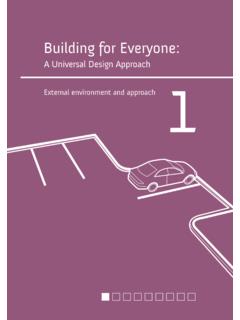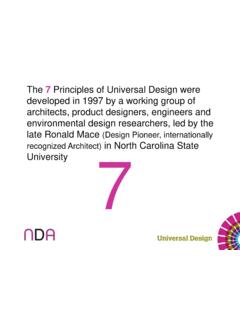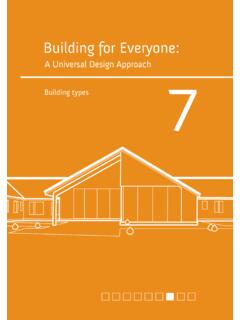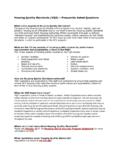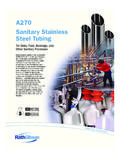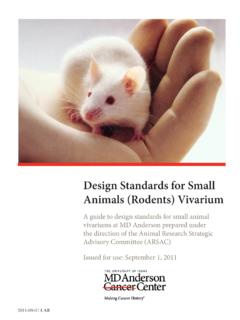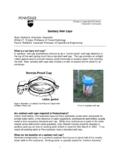Transcription of A Universal Design Approach 5
1 Building for Everyone:A Universal Design Approach sanitary facilities5 IICentre for Excellence in Universal DesignCreating an environment that can be used by all people, regardless of their age, size, disability or National Disability Authority s Centre for Excellence in Universal Design has a statutory role to promote the achievement of excellence in Universal Design in: the Design of the built and external environment product/service Design information and communications technologies (ICT) the development and promotion of standards education and professional development raising awareness of Universal designMore information and updates on the website at: 5 - sanitary facilitiesBuilding for EveryoneThe other booklets from the Building for Everyone series.
2 Booklet 1 - External environment and approachBooklet 2 - Entrances and horizontal circulationBooklet 3 - Vertical circulationBooklet 4 - Internal environment and servicesBooklet 6 - Facilities in buildingsBooklet 7 - Building typesBooklet 8 - Building managementBooklet 9 - Planning and policyBooklet 10 - Index and terminologyII Contents Objectives Introduction Terminology Design Issues 11 Building user needs 11 Scale of provision 11 Convenient access 13 Easy identification 14 Particular building types 14 Temporary facilities 19 Future proofing Single-Sex Toilets 22 Accessible toilet cubicles 22 Enlarged cubicles 27 Urinals Unisex Toilets 33 Unisex accessible toilet 33 WC pans and cisterns 38 Enlarged unisex accessible toilet with standing height washbasin 40 Family toilets 42 Baby-changing facilities Toilets for People Who Need Assistance 45 Unisex peninsular-arrangement toilet for assisted use 45 Unisex peninsular-arrangement toilet with adjustable changing bench and hoist facilities Shower Rooms and Bathrooms 51 Self-contained accessible shower 52 Accessible
3 Shower with WC 56 Shower and peninsular arrangement WC for assisted use 60 Bathroom for independent use 62 III Contents Objectives Introduction Terminology Design Issues 11 Building user needs 11 Scale of provision 11 Convenient access 13 Easy identification 14 Particular building types 14 Temporary facilities 19 Future proofing Single-Sex Toilets 22 Accessible toilet cubicles 22 Enlarged cubicles 27 Urinals Unisex Toilets 33 Unisex accessible toilet 33 WC pans and cisterns 38 Enlarged unisex accessible toilet with standing height washbasin 40 Family toilets 42 Baby-changing facilities Toilets for People Who Need Assistance 45 Unisex peninsular-arrangement toilet for assisted use 45 Unisex peninsular-arrangement toilet with adjustable changing bench and hoist facilities Shower Rooms and Bathrooms 51 Self-contained accessible shower 52 Accessible shower with WC 56 Shower and peninsular arrangement WC for assisted use 60 Bathroom for independent use Changing Areas 64 Self-contained accessible changing area 65 Communal changing and shower areas
4 Dwellings 68 Toilets 68 Bathrooms Detailed Design 75 Assistance alarms 75 Clothes hooks 80 Doors and locks 81 Fire alarm 84 Grabrails 85 Hair dryers 86 Hand-drying facilities 87 Heating 88 Lighting 88 Lockers 89 Mirrors 90 Shelves 91 Signage 91 Soap dispensers 93 Surfaces 93 Toilet paper dispensers 94 Vending machines 94 Waste disposal 95 Water supply 95A1 Definition of Universal Design 100A2 Human Abilities and Design 100A3 Further Reading 105 List of illustrations 109 Index 1114 Objectives The guidance in this booklet promotes the concept and philosophy of Universal Design and encourages developers, designers, builders and building managers to be innovative and think creatively about solutions that meet the needs of all building users.
5 The objectives of the series of booklets are to: identify and promote best practice with regard to Universal Design of the built and external environment provide best practice guidelines while recognising existing regulations in Ireland provide guidelines that are usable by and accessible to the target audience promote the achievement of Universal Design in IrelandThis booklet aims to: identify and promote best practice with regard to Universal Design of sanitary facilities increase awareness of, and to encourage designers to identify, the needs of all those who will be using the sanitary facilities highlight the wider benefits experienced by all when accessible and usable sanitary facilities are provided encourage designers to provide Universal Design solutions for sanitary facilities that look beyond the minimum requirements of national building regulations 5 How to use this guidanceThe guidance (Sections ) in this booklet is provided at three levels.
6 Section Highlights Design issues that should be considered for the building as a whole, ensuring that the overall provision is suitable for all building - Provides detailed Design guidance for individual rooms within a building, and includes a wide range of toilet, bathroom, shower room, and changing Focuses on the Design and provision of specific accessories and services that are common to all of the sanitary facilities described in Section - Section Introduction This booklet is part of the series Building for Everyone A Universal Design Approach , which aims to provide practical guidance on the Universal Design of buildings, places and facilities.
7 Universal Design places human diversity at the heart of the Design process so that buildings and environments can be designed to meet the needs of all users. It therefore covers all persons regardless of their age or size and those who have any particular physical, sensory, mental health or intellectual ability or disability. It is about achieving good Design so that people can access, use and understand the environment to the greatest extent and in the most independent and natural manner possible, without the need for adaptations or specialised solutions (see full definition in Appendix A1). Why Universal Design ?
8 People are diverse - some are left-handed and some right-handed - and people vary in their age, size and functional capacities. Illness or disability (whether 6temporary or permanent) can also affect characteristics, such as a person s mobility, dexterity, reach, balance, strength, stamina, sight, hearing, speech, touch, knowledge, understanding, memory, or sense of direction. A reference list with these booklets indicates some of the key differences in human abilities that should guide Design of buildings and of outdoor places. (See full description of Human Abilities in Appendix A2). People of diverse abilities should be able to use buildings and places comfortably and safely, as far as possible without special assistance.
9 People should be able to find their way easily, understand how to use building facilities, such as intercoms or lifts, know what is a pedestrian facility, and know where they may encounter traffic. Given the wide diversity of the population, a Universal Design Approach , which caters for the broadest range of users from the outset, can result in buildings and places that can be used and enjoyed by everyone. That Approach eliminates or reduces the need for expensive changes or retro fits to meet the needs of particular groups at a later stage. It is good practice to ascertain the needs of the range of expected users as early as possible, and to check the practicality and usability of emerging designs with a diverse user panel.
10 Designing for one group can result in solutions that address the needs of many others. For example: level entry (Step-free) entrances facilitate not just wheelchair users but also people with buggies; people with suitcases or shopping trolleys; people using walking or mobility aids; and people with visual difficulties larger toilet compartments provide easier access to wheelchair users; those with luggage or parcels; parents with pushchairs or accompanying small children; those using walking or mobility aids; and larger-sized people clear, well-placed signage that uses recognised symbols or pictograms helps people with reading or cognitive difficulties, and those whose first language is neither English nor IrishSometimes one solution will not suit all and a range of options will need to be provided, for example.
